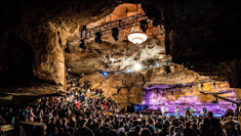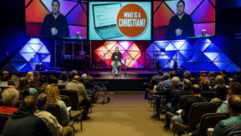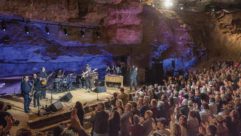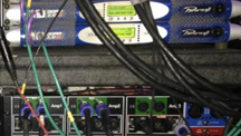
Arena Stage, Washington, D.C., Part 1
Jan 6, 2010 12:00 PM,
By Brad Hathaway
An ambitious rebuild in progress.

The venerable Arena Stage in Washington, D.C., founded in 1950, is getting a facelift and rededicated as the Mead Center for the American Theater. Along with the Stage’s two theaters—the Fishchandler Theatre (800 seats) and the Kreegar Theatre (514 seats)—the new facility will house a third theater, the Cradle, with 200 seats. Here, the center’s new lobby gets underway.
Photos Courtesy of Arena stage
Theaters around the world have been restored, renovated, or replaced; that’s nothing new. But encapsulated? Now that’s a new approach to modernization.
Related Links

Arena Stage, Washington, D.C., Part 2
When the Mead Center for the American Theatre—Arena Stage’s revitalized three-theater campus in Washington, D.C.—holds its gala opening later this year, it will be the culmination of the planning, balancing, testing, and installation efforts….

At the recent 2009 AES show in New York, Yamaha unveiled its “Rolling Showroom”—a 53ft., double expanding trailer that will make appearances at national tradeshows and events throughout North America. The unit is loaded with the latest pro audio gear from Yamaha and Nexo. Yamaha’s Marc Lopez gives us an exclusive tour. …
In Washington, D.C., the venerable Arena Stage has long operated a two-venue facility: its Fichandler Theatre, a 1961, arena-style house (hence the name) with some 800 seats; and the Kreeger, a 514-seat proscenium theater added in 1971. After 30-odd years, the company felt the need for modernization, expansion, and a touch of reinvention.
Enter Gilbert and Jaylee Mead and Bing Thom. The Meads, benefactors who have had a major impact on the entire Washington theater community through their support and enthusiasm, were willing to be the lead donors for what is to become the Mead Center for the American Theater; Thom, a visionary architect based in Vancouver, British Columbia, came up with a concept that matched the vision of the Meads and Artistic Director Molly Smith.

With the benefactors of Gilbert and Jaylee Mead, Bing Thom, the architect for the project, was able to execute a design that included tearing down everything but the auditoria to build a new structure to encapsulate the three venues into one space beneath a dramatic cantilevered roof.
Thom’s idea? Tear down the lobbies, the workshops, the administrative spaces, the dressing rooms—everything but the auditoria themselves, and then build a new structure around them, encapsulating the venerable venues with a new, highly dramatic and technologically up-to-date facility including one consolidated lobby area that would make visiting the Mead Center part of the event of theater-going. What’s more, the complex would include a third theater, a 200-seat flexible space dedicated to the development of new work called, not unreasonably, “The Cradle.”
All three theaters will sit beneath a dramatic cantilevered roof that is rounded on the east and south sides but sharpens to a point on the west pointing along the Washington waterfront toward the Washington Monument and the mall. Glass enclosed, what was once the highly identifiable exterior of the Fichandler Theatre will still be visible as theatergoers arrive at the main entrance along 6th Street in Southwest DC.

An artist’s rendering of what the Fichandler Theatre will look like inside the Mead Center for the American Theater. (Rendering by Bing Thom Associates.)
We took a hard hat tour of the facility recently as the major glass, concrete, and Parallam Parallel Strand Lumber structural work comes to a head. Parallam? That’s a composite wood product bound by epoxy that is usually used to make beams that can be stronger and longer than what could be carved out of a tree trunk. Here, the material creates gorgeous wooden columns that support the metal cantilevered roof while permitting the walls of some 370 panes of glass to create 35,000 square feet of window area. (Each Parallam column supports a load of 400,000lbs. of one of the largest cantilevers in the United States.)

The 1961 Fichandler Theatre now sits underneath a massive cantilevered roof—one of the largest cantilevers in the United States.
With some 14,000 cubic yards of concrete work, the glass, wood, and concrete feel will permeate the 200,000-square-foot facility. The exteriors of the Fichandler and Kreeger are being preserved while the new concrete exterior of The Cradle completes the expanse of the lobby area. Inside each venue, the mechanics and equipment are being completely updated to 21st century standards.

Arena Stage undertook a fundraising effort to support the $125 million project and had to suspend production at the facility during construction. For the past two years, Arena’s productions have been mounted in two houses away from their home base. That meant that the pre-Broadway engagement of Next to Normal was actually played in the temporary space in Crystal City on the Virginia side of the Potomac while Carrie Fisher’s Wishful Drinking, which Arena hosted in September of last year, was at the Lincoln Theatre on Washington’s historic U Street corridor.

Washington, D.C.’s Arena Stage under construction to become the Mead Center for the American Theater. Here, the composite wood (Parallam) columns support the 40,000lb. cantilever roof.
Construction is on schedule to accommodate Arena’s return with the 2010-2011 season. Washington theater-goers are already seeing visions of things to come, however, through the massive glass walls of the new Mead Center for the American Theater.
Brad Hathaway has written about theater for many publications, including livedesignonline.com, in which this article originally appeared.










